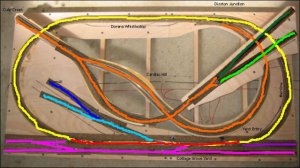I have purchased two Kalmbach wiring books and after attempting to read them find myself in a state of advanced flummoxment! Hope somebody can help before I turn my soldering iron on myself!!!!
Goals: I want this project to be as simple as possible. That said, I need the mainline segregated from the DISSTON BRANCH and also from the lower COTTAGE GROVE YARD track (not laid yet, but shown in the "will be" photo). Two locos will be the most run at any time.
Here's my layout as it stands today...
AS IS:

I have started connecting track to powersource to run a train around the mainline loop and have already hit a wiring issue. The red arrows indicated gapped rails. I connected power to the DISSTON JUNCTION jumper (just to the right of the red arrow on the mainline. Loco ran fine up to the YARD ENTRY rail gap, as expected. Connected YARD ENTRY switch from the point end (jumper is just to the right of red arrow gap) to power source, loco died. Switched polarity and loco ran over the switch to COTTAGE GROVE YARD and died at gap, as expected. Wired second switch (the one just above the words COTTAGE GROVE YARD) from points end, loco died. Switched polarity and loco still died. What the hey???
Suggestions?
BTW, here's my layout with unlaid track filled in using a cheesy graphics program so you get the idea...
WILL BE:

Thanks so much for your suggestions!!!
Edited for typos...
Goals: I want this project to be as simple as possible. That said, I need the mainline segregated from the DISSTON BRANCH and also from the lower COTTAGE GROVE YARD track (not laid yet, but shown in the "will be" photo). Two locos will be the most run at any time.
Here's my layout as it stands today...
AS IS:

I have started connecting track to powersource to run a train around the mainline loop and have already hit a wiring issue. The red arrows indicated gapped rails. I connected power to the DISSTON JUNCTION jumper (just to the right of the red arrow on the mainline. Loco ran fine up to the YARD ENTRY rail gap, as expected. Connected YARD ENTRY switch from the point end (jumper is just to the right of red arrow gap) to power source, loco died. Switched polarity and loco ran over the switch to COTTAGE GROVE YARD and died at gap, as expected. Wired second switch (the one just above the words COTTAGE GROVE YARD) from points end, loco died. Switched polarity and loco still died. What the hey???
Suggestions?
BTW, here's my layout with unlaid track filled in using a cheesy graphics program so you get the idea...
WILL BE:

Thanks so much for your suggestions!!!
Edited for typos...



